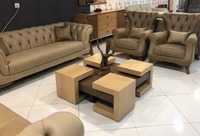Furniture encompasses a wide range of items designed for human use, typically within living or working spaces. These items serve functional purposes, such as providing seating, storage, or surfaces for activities like dining or working. Additionally, furniture often contributes to the aesthetic and ambiance of a space, reflecting personal style and cultural influences.
Furniture export is the process of selling furniture products manufactured in one country to customers in other countries. It involves everything from production and packaging to logistics and marketing strategies tailored for international markets. This sector plays a vital role in global trade and economic development, providing opportunities for businesses to expand their reach and for consumers to access a diverse range of furniture options.
several steps
1. Market Research: Identify target markets based on factors like demand, competition, regulations, and cultural preferences.
2. Product Selection: Choose furniture items that have export potential and are suitable for the target market's tastes and requirements.
3. Quality Control: Ensure that the furniture meets international quality standards and regulations for safety, durability, and materials.
4. Packaging: Develop packaging solutions that protect the furniture during transit and comply with shipping regulations.
5. Logistics: Arrange transportation, including shipping, freight forwarding, and customs clearance.
6. Documentation: Prepare export documents such as invoices, packing lists, certificates of origin, and shipping contracts.
7. Marketing: Promote the furniture through various channels such as trade shows, online platforms, and partnerships with local distributors.
8. Compliance: Ensure compliance with export regulations, including trade agreements, tariffs, and import restrictions in both the exporting and importing countries.
9. Payment: Decide on payment terms and methods, considering factors like currency exchange rates, payment security, and international banking regulations.
10. Customer Support: Provide after-sales support and services to maintain customer satisfaction and loyalty.
By following these steps and adapting to the specific requirements of each target market, furniture exporters can successfully enter and compete in the global marketplace.
Exporting air furniture is an intriguing concept, though it doesn't refer to physical furniture made of air. Instead, it could mean exporting lightweight, inflatable furniture items such as inflatable sofas, chairs, or mattresses. These items are popular for their portability, ease of storage, and versatility, especially for outdoor or temporary use. Exporting air furniture would involve similar steps to exporting traditional furniture, including market research, product selection, logistics, and compliance with regulations. Additionally, emphasizing the benefits of lightweight and space-saving features could be crucial in marketing air furniture to international markets.
"Furniture land export" could refer to the export of furniture products from a specific region or country known for its furniture manufacturing industry. For example, if there is a place called "Furniture Land" known for producing high-quality furniture, exporting furniture from that region could be referred to as "Furniture Land export."

The process would involve the same steps as general furniture export, such as market research, product selection, logistics, documentation, and compliance. Additionally, leveraging the reputation and unique selling points of Furniture Land, such as craftsmanship, design expertise, or special materials, could be key in marketing the exported furniture to international buyers.
"Furniture sea export" likely refers to the transportation of furniture products via sea freight for export purposes. Shipping furniture by sea is a common method due to its cost-effectiveness for bulky and heavy items like furniture.
The process involves several steps
1. Packaging: Properly package the furniture to ensure it is protected during transit. This may involve using materials such as bubble wrap, cardboard, or wooden crates.
2. Booking: Arrange transportation with a shipping company or freight forwarder, booking space on a cargo vessel.
3. Documentation: Prepare the necessary export documentation, including invoices, packing lists, bills of lading, and certificates of origin.
4. Loading: Deliver the packaged furniture to the port of departure, where it will be loaded onto the cargo vessel.
5. Transit: The furniture will be transported by sea to the destination port, which could take several days or weeks depending on the distance.
different aspects
Landing furniture export levels" could refer to different aspects:
1.Geographical Levels: This could indicate the regions or countries to which furniture exports are being sent. For example, a company might track their furniture export levels to different continents (North America, Europe, Asia, etc.) or specific countries within those continents.
2. Quantitative Levels: This could refer to the volume or quantity of furniture being exported. Companies might analyze their export levels in terms of the number of units shipped, weight, or value of the furniture products.
3. Market Penetration Levels: This could indicate how deeply a furniture exporting company has penetrated various international markets. It may involve analyzing market share, growth rates, or customer preferences in different regions.
4. Performance Levels: This could involve evaluating the performance of furniture exports over time, looking at trends, fluctuations, and overall growth or decline in export levels.

Understanding these levels can help furniture exporters make informed decisions about market expansion, resource allocation, and strategic planning to optimize their export operations.
The top furniture-exporting countries vary depending on the type of furniture and market conditions
some of the major exporters
1. China: China is one of the largest exporters of furniture globally, producing a wide range of furniture items at various price points.
2. Germany: Known for its high-quality craftsmanship and design, Germany is a significant exporter of furniture, particularly luxury and specialty items.
3. Italy: Italy is renowned for its luxury furniture brands and high-end design, making it a key player in the global furniture export market.
4. Poland: Poland has emerged as a major furniture exporter in recent years, specializing in affordable and functional furniture products.
5. Vietnam: Vietnam has become a prominent player in the furniture export market, known for its competitive pricing and efficient manufacturing processes.
6. United States: The United States exports a significant amount of furniture, particularly office furniture, to various countries around the world.
These countries are among the top exporters of furniture globally, but other countries also play important roles in the furniture export market, depending on factors such as production capacity, quality, and market demand.